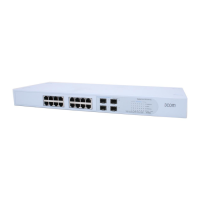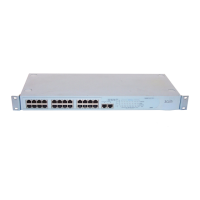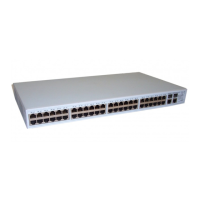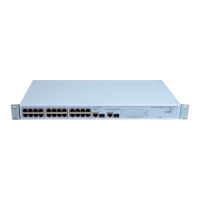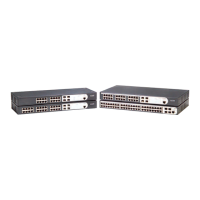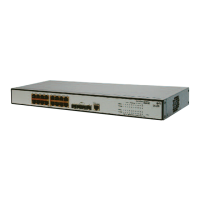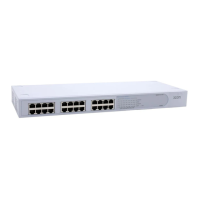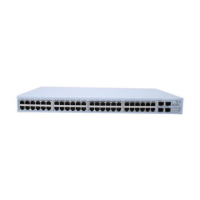
Do you have a question about the 3Com Baseline 2848-SFP Plus and is the answer not in the manual?
| Ports | 48 x 10/100/1000 |
|---|---|
| SFP Ports | 4 |
| Switching Capacity | 104 Gbps |
| Forwarding Rate | 77.4 Mpps |
| MAC Address Table Size | 8K entries |
| Jumbo Frame Support | Yes |
| Manageable | Yes |
| Layer | Layer 2 |
| Power Supply | Internal Power Supply |
| Operating Temperature | 0°C to 40°C |
| Storage Temperature | -40°C to 70°C |
| Operating Humidity | 10% to 90% non-condensing |
| Model | Baseline 2848-SFP Plus |
| Type | Managed Switch |
| Features | VLAN, QoS, Port Mirroring |
| Dimensions (W x D x H) | 440 x 44 x 44 mm |
| Storage Humidity | 10% to 95% non-condensing |
Details the switch's 44 auto-negotiating ports, 4 Gigabit combo ports, and Gigabit Ethernet functionality.
Details the four SFP ports supporting Gigabit Ethernet transceivers for flexible fiber connectivity.
Provides instructions and precautions for connecting and supplying power to the switch.
Details the process of using SFP transceivers, including approved types and insertion/removal.
Provides step-by-step instructions on how to properly insert an SFP transceiver into the switch's SFP slot.
Details the steps to run the Discovery application, detect devices, and launch the web interface.
Provides instructions for logging into the switch's web interface using default credentials.
Explains how to access the web interface directly by knowing the switch's IP address.
Describes how to view system, IP, switch, and management software information from the summary screen.
Provides instructions on how to set or change the administrator password for web interface security.
Step-by-step guide to set the admin password, including old password, new password, and confirmation.
Explains how to assign an IP address to the switch via DHCP or static assignment.
Describes how the switch automatically assigns an IP address if none is configured, based on its MAC address.
Guides on how to set the IP address and subnet mask via the IP Settings screen.
Details configuring port settings like speed, duplex, flow control, priority, and status via basic and advanced tabs.
Details settings for broadcast storm control and packet rate thresholds on ports.
Explains the concept of VLANs and how to organize ports into separate broadcast domains for network segmentation.
Guides on creating new VLANs and assigning VLAN IDs, with warnings about management VLAN.
Explains how to assign ports as Not a member (N), Tagged (T), or Untagged (U) within VLANs.
Describes how to change the port mode (N, T, U) for selected VLANs.
Details how to group ports into trunks for increased bandwidth and fault recovery.
Lists rules and limits for creating trunks, including port membership and trunk count.
Guides on using the Membership/Setup tab to assign ports to specific trunk groups.
Explains how to modify trunk name, speed, duplex, and flow control settings.
Details how to monitor network traffic on a specific port using a network analyzer.
Provides steps to configure traffic monitoring by defining monitor and analyzer ports.
Explains how to run cable diagnostic tests to detect and resolve issues with attached network cables.
Describes the restart function, its effect on connections, and comparison to power cycling.
Explains how to reset the switch to factory defaults, and back up or restore configuration settings.
Guides on resetting the switch to its factory defaults to resolve operational issues.
Details procedures for backing up current settings and restoring them later.
Explains how to upgrade the switch's system software via HTTP.
Describes the firmware upgrade process, precautions, and completion indicators.
Explains the Spanning Tree protocol for preventing network loops and ensuring optimal paths.
Provides steps to recover access if the web interface password is forgotten, involving a factory reset.
Explains how to regain access if the static IP address is forgotten, using the Discovery application.
Helps diagnose problems by referencing LED status indicators described in Chapter 1.
Helps troubleshoot situations where the link status LED does not light up for a connected port.
Guides on upgrading firmware if the switch's firmware image becomes corrupted.
Details how to recover the switch by resetting to factory defaults if IP address, username, or password is lost.
Guides on obtaining telephone support and repair services, including required information.
Provides critical safety warnings for installation, operation, and handling of the switch.
Warns against looking directly into fiber optic ports or cables when powered on due to laser safety.
Warns about potential hazardous laser emissions from controls or procedures not specified in the manual.
